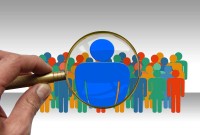- Home
- Business Processes
- Industry Knowledge
- Aerospace Industry
- Automotive Industry
- Banking Domain
- BFSI Industry
- Consumer/ FMCG Industry
- Chemicals Industry
- Engineering & Construction
- Energy Industry
- Education Domain
- Finance Domain
- Hospitality Domain
- Healthcare Industry
- Insurance Domain
- Retail Industry
- Travel and Tourism Domain
- Telecom Industry
- Leadership Skills
- eLearning
- Home
- Leadership
- Leadership & Management
- Value – Key Driver of Change
Value – Key Driver of Change
Productivity is defined not in terms of the number of goods produced, but in terms of value-added per employee. Customers don’t really buy goods and services but in fact, they buy a value - something they value. The future is all about tangible products fulfilling intangible needs. Ideas like this can transform a business and provide them a competitive advantage to thrive in the future.
People Look for Intangible Benefits
People, as Theodore Leavitt pointed out long ago, don't really buy goods and services. They buy a value - something they value. The customers want the goods or services to be accompanied by intangible benefits associated with availability at the right time and place and to express the values they require.
On the weekend of the Christmas holiday, David had a breakdown with his electricity. He took a service from Urban Clap and the person diagnosed and corrected a very small fault which had put the central heating out of action, and put it right. On that day Urban Clap was not selling them a service or a spare part, they were selling peace of mind on a festival day. That is the value that was given even when it’s not needed. It’s the confidence that someone will come when David needs one.
The enterprise providing the value is able to share economics with the consumer by using as little matter as possible in the preparation of the goods or services. So automation and materials technology keep down the amount of processing and actual stuff that has to go into the provision of goods and services.
The idea of “No-Matter”
Automation and materials technology keep down the amount of processing and actual stuff that needs to go into the production and provision of services. Products will be produced more quickly and cheaply, and with less final bulk and weight. The phrase “No Matter” encapsulates all this competitive advantage and value add. 'No matter' as a concept also includes the role of the disposable, though we have to watch its impact on the environment. The idea of no matter also covers the idea of the invisible purpose behind a sale.
For example, the invisible purpose behind a drill is not the selling of drills as such, but rather to sellability to make holes. If you use a laser drill, you are very much into the realm of 'no matter', for the laser produces holes which are by definition the absence of matter. This is all a question of tangible products fulfilling intangible needs. Ideas like this can transform a business. It is all about the effectiveness of outcomes rather than the efficiency of inputs. So the physical and the intellectual blend in the marriage of the changing mindset and the future mindset.
Mass Customisation
Next is the paradoxical idea of 'mass customization'. This is providing the customer with precisely what he or she requires, such as a garment to suit a bulky or a slender frame. Providing something that is non-standard yet can be produced as goods of standard size, weight, or other requirements. The technology now permits the non-standard to be produced on the standard line. Just a change of the computerized instructions and the trick is performed. Now customers don’t want to wait for something that is made to measure.
The same technique of mass customization can be used to provide cultural variations required in various parts of the world without setting up a special production line. The mass economy provides the benefit of scale; mass customization allows for the differentiation and individualization of requirements.
Future Trends and Change
Not so long ago you can imagine how some traditional business houses would have resisted such changes in the mindset and approach. Managers today need to group the changes which have had the biggest impact on business, industry, and society. Types of technological development have to be focused on the understanding of futurology. They can no more stick to what they know we are good at and so on. There is an emerging need to approach the present from the standpoint of the future. That's how all these developments have occurred- so much so that we find it difficult to realize the amount of resistance they initially caused.
Many of these developments are at a relatively early stage, so there is much more to follow. It is essential that managers who are going to have to cope with such changes see them as a part of their functions to educate their workforces to understand the nature of the changes we can expect, of the world in which we live and the future we can create.
Related Links
You May Also Like
-
In its simplest sense, decision-making is the act of choosing between two or more courses of action. Decision making is a key skill in the workplace and is particularly important if you want to be an effective leader. When decisions have to be made, there are several stages that you should go through to reach a practical solution. Understand the meaning and importance of decision making and how to look at it as a process.
-
As we know change is inevitable as market expectations are not static, new technology is constantly being developed, and organizational responses are inevitable to these sequences. It is a simple matter of business evolution. If every manager and every employee could have some understanding of the triggers of change and their relationships with each other, then the acceptance to change would be easier.
-
Stress is a product of the busyness of modern life. It has assumed grave dimensions ever since the emergence of industrialism. In fact, stress is a natural, ongoing, dynamic, and interactive process that takes place as people adjust to their environment. Stress can be brought about by positive or negative life events. Distress can cause disease and eustress or positive stress can promote wellbeing and increased productivity. Learn to recognize and be responsible for your stress, and learn the ways to manage stress.
-
Recognizing Stress & its Sources
As an individual, you almost certainly know what stress feels like. Stressors are events or situations to which people must adjust. Stressors may be physical or psychological in nature. The level of severity of stress is determined not merely by exposure but the intensity, duration, and frequency of stressors. The sources of stress are many. They arise from multiple areas both with the individual and from the environment.
-
How often do you have a plan for how you are going to spend your day but you aren't able to complete the tasks on your plan because of unimportant tasks, interruptions, or your own procrastination? Wouldn't it be great to be able to manage your schedule and your time while avoiding, or at least controlling, these time stealers? Learn the strategies to manage your schedule while still handling interruptions and demands on your time.
-
Technological advancement has brought about radical changes in the methods of work and also in the organizational structure and talent strategies. The future of work is transforming our work, workforce, and workplace. Some important trends observed during recent times are discussed below.
-
Creating Highly Effective Teams
How do we create effective teams? What comes to mind when you think about an effective team? High performing teams exhibit accountability, purpose, cohesiveness, and collaboration. It is a team that works seamlessly as a whole. Everyone brings unique talents and strengths and support each other to bring out the best in everyone. How do you create one?
-
Crisis leadership is a very important part of leading in today's world. The skills a leader needs in order to guide people during a crisis are different from the skills needed to help a group grow. Are you a good crisis leader? What is your leadership style in case of a business crisis situation? A business crisis can test the strongest of leaders, read this article to explore how to ensure you’re ready to take action and weather the storm when one strikes you.
-
Collaborative leadership is all about collaborative problem-solving and decision-making or can also be defined as the leadership of a collaborative effort. . The term started to appear in the mid-1990s in response to the formation of long term public-private partnerships to rebuild public infrastructure. Learn how you can use principles of collaborative leadership to enhance your leadership skills for being an effective leader.
-
Participative leadership is one of the most effective styles and creates higher productivity, better contributions from group members, and increased group morale. The democratic leadership style consists of the leader sharing the decision-making abilities with group members by promoting the interests of the group members. Learn more about this leadership style and situations when it is effective.
Explore Our Free Training Articles or
Sign Up to Start With Our eLearning Courses

About Us
Learning
© 2023 TechnoFunc, All Rights Reserved










